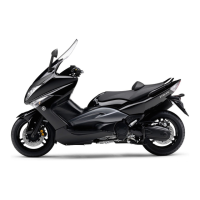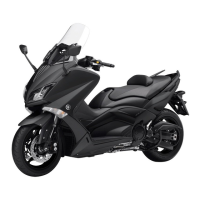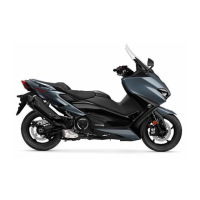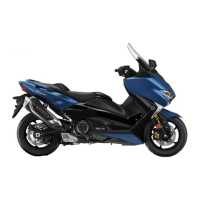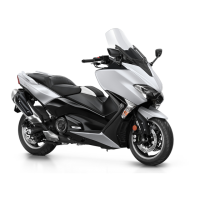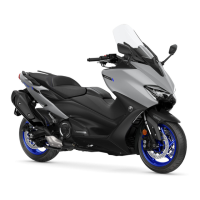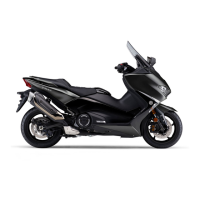Do you have a question about the Yamaha Tmax XP500 2016 and is the answer not in the manual?
Owner's responsibility for safe operation, understanding requirements before riding.
Importance of pre-operation checks, rider visibility, and avoiding hazards.
Recommendations for helmets, clothing, and footwear to prevent injuries.
Precautions regarding carbon monoxide hazards from engine exhaust.
Advice on signaling, braking on wet surfaces, and navigating various road conditions.
Location and identification of all handlebar controls and dashboard instruments.
Guidelines for carrying and using the smart key and its backup mechanical key.
Instructions and indicators for replacing the battery in the smart key fob.
Steps to turn on vehicle power and release the steering lock using the smart key.
Procedure for turning off the vehicle's power using the smart key system.
Details on turn signal, high beam, engine trouble, and ABS warning lights.
Overview of the multi-function display, its modes, and indicators.
Functions of the left and right handlebar switches for various operations.
Explanation of the Anti-lock Brake System operation and its warning light.
Check fuel level, refuel if necessary, and inspect fuel lines and tank breather hose.
Check engine oil level, add oil if needed, and check for oil leakage.
Check coolant level and inspect the cooling system for leaks.
Check front brake operation, fluid level, pads, and hydraulic system for leaks.
Check rear brake operation, fluid level, pads, and hydraulic system for leaks.
Ensure smooth operation and check throttle grip free play.
Inspect wheels and tires for damage, check tread depth, and verify air pressure.
Ensure smooth operation of brake levers and lubricate pivot points if necessary.
Check operation of centerstand and sidestand and lubricate pivots if needed.
Check the operation of instruments, lights, signals, and switches.
Check the operation of the ignition circuit cut-off system related to the sidestand switch.
Schedule for emission control system maintenance based on mileage and time.
Schedule for general maintenance and lubrication tasks based on mileage.
Procedure for checking spark plug condition, gap, and identifying engine issues.
How to check engine oil level and replace the engine oil and oil filter.
Procedure for checking coolant level and adding coolant if necessary.
Step-by-step guide for replacing the air filter element.
Importance of tire condition, replacement, and types.
Procedure to check brake fluid level and indications of low fluid.
Instructions for identifying and replacing blown fuses in the fuse boxes.
General information on troubleshooting common problems with the scooter.
Checks to perform if the smart key system is not functioning correctly.
Flowcharts to diagnose starting problems or poor engine performance.
Troubleshooting steps for engine overheating, including coolant checks.
Procedure to operate the vehicle in emergency mode when the smart key is lost.
Owner's responsibility for safe operation, understanding requirements before riding.
Importance of pre-operation checks, rider visibility, and avoiding hazards.
Recommendations for helmets, clothing, and footwear to prevent injuries.
Precautions regarding carbon monoxide hazards from engine exhaust.
Advice on signaling, braking on wet surfaces, and navigating various road conditions.
Location and identification of all handlebar controls and dashboard instruments.
Guidelines for carrying and using the smart key and its backup mechanical key.
Instructions and indicators for replacing the battery in the smart key fob.
Steps to turn on vehicle power and release the steering lock using the smart key.
Procedure for turning off the vehicle's power using the smart key system.
Details on turn signal, high beam, engine trouble, and ABS warning lights.
Overview of the multi-function display, its modes, and indicators.
Functions of the left and right handlebar switches for various operations.
Explanation of the Anti-lock Brake System operation and its warning light.
Check fuel level, refuel if necessary, and inspect fuel lines and tank breather hose.
Check engine oil level, add oil if needed, and check for oil leakage.
Check coolant level and inspect the cooling system for leaks.
Check front brake operation, fluid level, pads, and hydraulic system for leaks.
Check rear brake operation, fluid level, pads, and hydraulic system for leaks.
Ensure smooth operation and check throttle grip free play.
Inspect wheels and tires for damage, check tread depth, and verify air pressure.
Ensure smooth operation of brake levers and lubricate pivot points if necessary.
Check operation of centerstand and sidestand and lubricate pivots if needed.
Check the operation of instruments, lights, signals, and switches.
Check the operation of the ignition circuit cut-off system related to the sidestand switch.
Schedule for emission control system maintenance based on mileage and time.
Schedule for general maintenance and lubrication tasks based on mileage.
Procedure for checking spark plug condition, gap, and identifying engine issues.
How to check engine oil level and replace the engine oil and oil filter.
Procedure for checking coolant level and adding coolant if necessary.
Step-by-step guide for replacing the air filter element.
Importance of tire condition, replacement, and types.
Procedure to check brake fluid level and indications of low fluid.
Instructions for identifying and replacing blown fuses in the fuse boxes.
General information on troubleshooting common problems with the scooter.
Checks to perform if the smart key system is not functioning correctly.
Flowcharts to diagnose starting problems or poor engine performance.
Troubleshooting steps for engine overheating, including coolant checks.
Procedure to operate the vehicle in emergency mode when the smart key is lost.
| Displacement | 499cc |
|---|---|
| Bore x Stroke | 66.0 mm x 73.0 mm |
| Compression Ratio | 10.9:1 |
| Fuel System | Fuel Injection |
| Ignition System | TCI |
| Starter System | Electric |
| Transmission | V-Belt Automatic |
| Front Suspension | Telescopic forks |
| Rear Suspension | Swingarm |
| Front Brake | Dual hydraulic disc |
| Front Tyre | 120/70-15 |
| Rear Tyre | 160/60-15 |
| Dimensions (L x W x H) | 2, 200 mm x 775 mm x 1, 420 mm |
| Seat Height | 800 mm |
| Wheelbase | 1, 580 mm |
| Wet Weight | 217 kg |
| Engine Type | Liquid-cooled, 4-stroke, DOHC, 4-valve |
| Rear Brake | Hydraulic disc |
| Fuel Tank Capacity | 15.0 L |

